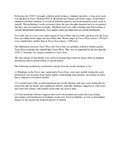| dc.description.abstract | Following the 1970-71 drought, which resulted in heavy elephant mortality, a long-term study was initiated in Tsavo National Park to determine movements and home ranges of individual elephants and their relations to overall distribution patterns and environmental factors such as rainfall. The preliminary results presented show the post-drought situation but it is recognized that they may not represent normality. Methods used were radio-tracking and observations of visually identifiable individuals. Two aerial counts provided data on overall distribution.
Two bulls and two cows were radio-tagged in Tsavo West and two bulls and four cows in Tsavo East, providing home range and movement data. Home ranges in Tsavo West (mean = 350 km2) were considerably smaller than in Tsavo East (mean = 1580 km2).
The differences between Tsavo West and Tsavo East are probably related to habitat quality, Tsavo East receiving less rainfall than Tsavo West. This view is supported by the fact that the 1970-71 mortality was largely confined to Tsavo East.
The movements of individuals were useful in interpreting relatively major shifts in elephant distribution that occurred within a 4-month period.
The following preliminary conclusions emerge from the results obtained so far:
(1) Elephants in the Tsavo area, particularly Tsavo East, were more mobile during the study period than was assumed from earlier studies, undertaking long-distance movements in fairly direct response to localized rainfall.
(2) A subdivision of the overall population into locally distinct units may exist during the dry season but did not obtain after significant rainfall, when the elephants ranged over wide areas and came into contact with animals from other dry-season units.
(3) Circumstantial evidence suggests that food is the primary proximal factor governing movements and distribution of elephants in the area. Food availability, in turn, is determined largely by the spatial and temporal pattern of rainfall. | en_US |

